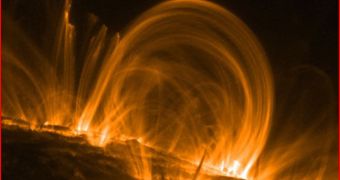Because plasma is mostly composed of charged particles, such as electrons and ions, which have a global neutral charge, it is able to generate powerful magnetic fields, a very important feature if you ask a nuclear physicist working on the design of a nuclear fusion reactor. However, all good things must also have bad aspects as well, and when it comes to plasma magnetic reconnection there are. Magnetic reconnection represents a phenomenon in which magnetic fields originating from different sources break up and connect to each other, while high amounts of energy are released.
Magnetic reconnection can be routinely observed on the surface of the Sun, during the release of energy in the form of solar flares, and on Earth during intense aurora activity. Magnetic reconnection is also one of the factors that prevents physicists from creating nuclear fusion reactors that have high-efficiency electric energy production capabilities. As you probably already known, nuclear fusion reactors use powerful magnetic fields to confine a hot plasma gas. In order to produce the magnetic fields, one must provide high quantities of electric energy. But, due to magnetic reconnection, usually a nuclear fusion reactor drains more power to generate the magnetic fields than it produces by nuclear fusion, mostly meaning its operation is useless.
On the other hand, the ESA Cluster mission studying the magnetic reconnection phenomenon has recently revealed that the regions required to determine a magnetic reconnection must be much larger than predicted. The area where the magnetic reconnection process is initiated is called the 'electron diffusion region', which can span in an area measuring 2 to 10 kilometers, thus the chance that we may be able to study these regions in the near future is rather remote.
Nonetheless, computer simulations may provide a partial explanation on the processes that take place during a magnetic reconnection event, in the electron diffusion regions. Five years ago, the satellites from the ESA Cluster program detected what seemed to be a turbulent plasma region in the Earth's magnetosheath, measuring a massive 3,000 kilometers in length. Although it is 300 times longer than previously predicted by theory and at least four times bigger that seen in computer simulations, the new simulations seem to correlate perfectly with the observations.
ESA satellites are capable of making high-resolution images of magnetic and electric fields, however higher resolution observations on the electron diffusion regions are required, in order to make precise measurements. NASA will complement ESA's fleet of magnetic imaging satellites with a number of four other satellites in the year 2014, which will be able to conduct simultaneous measurements on the effects determined by the magnetic reconnection phenomenon.

 14 DAY TRIAL //
14 DAY TRIAL //